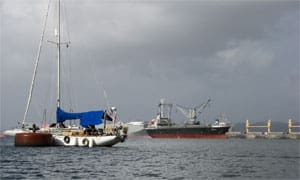Editor’s note: This is the second part of a multipart series, “The toughest passages of 50,000 miles,” a look at the most difficult aspects of circumnavigators Ellen and Seth Leonard’s various ocean voyages.
In the last installment of this series (“Worst weather challenges,” September/October 2019, Issue 257), I covered the two passages that Seth and I considered our toughest in terms of weather and sea conditions. But challenging gales and storms are not the only ways in which a passage can be trying. Gear failures and breakages can be just as difficult and even threatening.
Like many sailors, we’ve also had troubles with the “Iron Mainsail.” This has mostly been due to the fact that for much of our 50,000 miles, our engines have been old and very used. We were even given an old transmission for free when we put in a 20-year-old, raw-water-cooled Yanmar to replace our 40–year-old, oil-spewing Westerbeke. We knew there was likely a reason it was free, but the transmission did just fine for the first few months. Not until Australia dropped below the horizon behind us on the first leg of our Indian Ocean crossing did we have problems. The clutch was slipping, we were already out of sight of land — and it was dead calm.
For six days we drifted. We didn’t have the parts or the expertise to rebuild the transmission, and once a clutch starts slipping it just gets worse with use. We decided to save any life that was left in it in case we had to motor the last bit into the anchorage in the Cocos Keeling atoll. Slowly, painfully slowly, the west-setting current took us toward the wind line 200 miles away. Under the baking sun, the sea was deep blue and mirror still. The enormous brown bodies of Australia’s deadly sea snakes rippled across the surface. An oily swell kept Heretic, our 1968 cutter, rolling constantly. The mainsail, hoisted and centerlined to stabilize Heretic, slatted loudly despite the two reefs we’d put in. By the fifth day, even though we still had plenty to drink, both of us could empathize with the maddened, becalmed sailors in The Rime of the Ancient Mariner.
This experience — certainly our most tedious passage ever — would also have taken honors as our worst breakage on passage, except that it was completely outdone by an earlier event. It might be stretching it a bit to call the Panama Canal a “passage,” but as it happens to be the only section of a circumnavigation for which you actually must have an engine, and as we ended up not having an engine, our experience in the canal was definitely the worst underway breakage of our 50,000 miles.
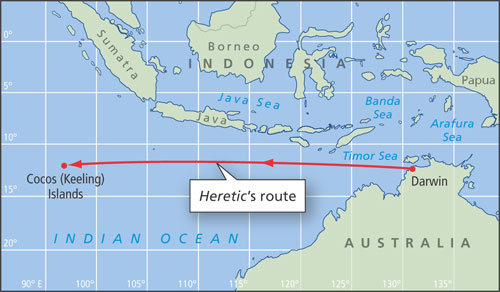 |
|
On a leg from Darwin to Cocos Keeling Island, the voyaging couple lost their clutch. |
Everything seems fine
When we arrived in Colon at the Caribbean entrance to the Panama Canal, Heretic appeared to be in fine shape, waiting only for provisions to tackle the Pacific crossing just on the other side of the isthmus. Seth and I, along with our two friends who were aboard with us at the time, quickly got started on the whole bureaucratic process of transiting that isthmus. Since we were sailing on the proverbial shoestring, we were relieved to discover that we did not need to hire an expensive agent but instead could deal with a facilitator we met at the Panama Canal Yacht Club. That convivial watering hole of waiting voyagers has since been requisitioned and bulldozed, but at the time the club was a quiet haven where one could grab a cheap beer and burger and meet other sailors and the facilitators. Our facilitator was a godsend. For only $50, he drove us to all the necessary offices, translated for us, helped us with the reams of paperwork, rented the big ropes and tire fenders we would need, and got our transit scheduled for only 10 days away — a real feat when sailors were waiting weeks.
The day came. Half an hour before the appointed time that evening, we weighed anchor and made our way to the rendezvous point with the pilot boat that was to bring out our transit adviser. A large, genial man stepped aboard Heretic and introduced himself as Cooper. As dusk fell, we made our way toward Gatun locks, the three giant locks that lift vessels 85 feet to the artificial Gatun Lake that comprises most of the canal. Following Cooper’s instructions, we rafted to a tug against one wall and consequently had no need to handle lines, despite having the required five people on board: helmsman (Seth) and four line handlers (me, our two friends and Seth’s dad who had flown in to join us). So, we could look around at the ships sharing the lock with us, at the “mules” (electric locomotives) that handle the cables that keep ships in place in the lock, and at the water swirling fast into the lock, raising us a third of the way up in only 15 minutes. The whole experience was made that much more dramatic by the nighttime darkness and the artificial light on the turbulent water.
Puttering out into Gatun Lake brought the dark and quiet of the wilderness; the whole lake is surrounded by rainforest. We tied up to one of the two huge red buoys where Pacific-bound sailboats await the next day of transit. We had dinner together with Cooper and then the pilot boat came to take him home. We went to sleep in our bunks thinking all was well and filled with the excitement of experiencing this great marvel of engineering and history.
Dawn broke with the haunting calls of howler monkeys in the jungle around us, a new sound to us and an eerie one. We made coffee and soon our new adviser, George, arrived. What followed was probably his worst day on the job ever. It was certainly one of the worst days of our circumnavigation.
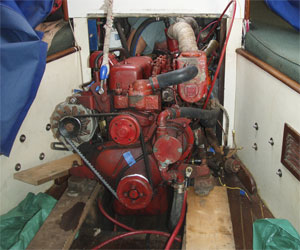 |
|
Repairing the engine in Panama City involved moving the engine forward to rebuild the bed logs. |
Dead in the water
We slipped the mooring lines and got underway, but we hadn’t even made it into the main channel before Heretic slowed markedly. The engine still revved along, but there was no forward motion. Heretic was soon dead in the water. Seth opened the engine hatch in the cockpit; sure enough, the propeller shaft was not moving. In a moment of denial and moderate idiocy, we rolled out the jib. There was wind enough for sailing on Gatun Lake, but we hadn’t thought ahead to what we would do in the locks down to the Pacific. George the adviser had been perplexed by the slowdown but, upon seeing the jib, he leapt to his feet in anger. “Sailing is not permitted!” he shouted.
Having read a little bit about the history of the Panama Canal, I found this not a little bit ironic: When the Gatun Yacht Club had been in operation, sailboats raced on the lake, and John Guzzwell aboard his famous little yacht Trekka — at the time, the smallest boat to sail around the world — had sailed a good portion of his transit.
My appreciation of the irony didn’t last, though. Dutifully rolling up the jib, we now had no propulsion and were drifting aimlessly. George, seeing this and not understanding our explanation that sailing — even tacking back and forth in one spot — would solve the problem, became desperate. He demanded that we anchor.
Gatun Lake is a flooded forest. It was made by damming the Chagres River, which means there are countless dead tree trunks underwater there. It doesn’t take a whole lot of nautical know-how to realize that this means there is a high probability of snagging the anchor and never retrieving it. Which is exactly what happened. George called the pilot boat, which arrived to tow us back to the big red buoy where we’d spent the night. Even they, with their powerful engine and winch, couldn’t get our anchor and chain back. All $600 of chain and anchor was gone. We buoyed it, hoping to retrieve it somehow, but of course our buoy was gone by the next morning.
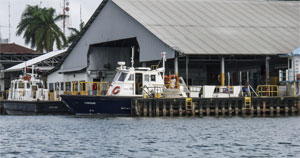 |
|
The Gatun locks operations dock. |
We secured the tow rope to Heretic and the pilot boat got in gear, powering up to its cruising speed of 9 knots. We yelled and waved our arms, trying to get them to slow down; this was way too fast to be towing our 24,000-pound cruising boat. They slowed down before anything broke, fortunately, but then we learned that this tow — to go no more than 300 yards — was going to cost us $470. It would be deducted from the deposit of $2000 we had made to transit the canal. At the time, the transit fee was $600, so we had expected to get $1400 of our deposit returned. This was more than 12 years ago, when those numbers meant rather more than they mean today. And that money meant a lot — months of voyaging — to us on our threadbare budget.
We reached the big red buoy and made fast. George, who had been madly trying to explain on the phone to his superiors the disaster for which they considered him responsible, got ready to depart on the pilot boat. He was eager to be gone and eager to get through the reprimand he was in for. We delayed him just long enough to make our own day worse. What would happen now, we wanted to know. Would we get a tow? How much would that cost?
More than we could afford, came the answer, doubtless true. We should fix the engine and report to the Port Captain in Colon to reschedule the transit. It was one of those sentences that look just fine on paper, especially red-taped paper, but that make no sense in real life. Engine aside, how were we supposed to reschedule our transit? Our facilitator had moved heaven and earth to get us an early slot. How were we even supposed to find the Port Captain? Could just any random person walk into his office? How were we even supposed to get to shore?
Then came the worst. Of course, said George, as if we’d orchestrated this whole thing intentionally, we’d be fined the rest of our deposit for holding up our transit. That $1400 we’d expected to have back? That was supposed to cover our provisioning and maintenance for an entire season of cruising the Pacific? Gone.
George and the pilot boat departed, and we stared at each other. Then Seth’s dad opened the hatch to the engine and he and Seth got to work.
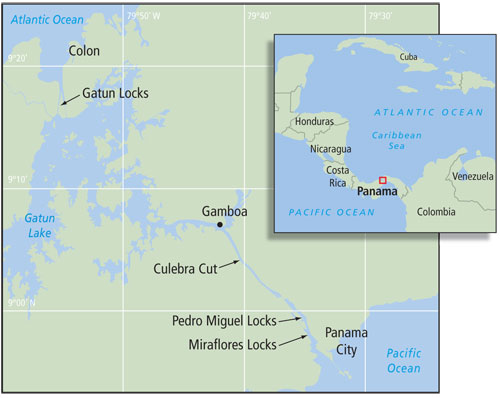 |
|
Heretic was in Gatun Lake when the engine failed and required repair to continue, since sailing is prohibited in the canal. |
A sheared shaft key
It didn’t take long to discover that the problem was irreparable in the midst of the jungle. The key between the prop shaft and the coupler had sheared, and the bronze shaft was completely mashed at that end. We’d need to get the shaft re-machined at the very least, if not get a whole new one. That meant taking the propeller off and taking the shaft out of the boat, a task for which it’s obviously better to be hauled out of the water. Even if we did manage to dive down and do that, and plug the inch-wide hole, we’d still need a machine shop to fashion a new shaft. Then we’d need to re-align the engine.
Investigating further, we saw that the problem had begun a long time ago. The bed logs on which the engine rest had never been sealed in fiberglass or even just paint. Water had gotten into the wood and slowly rotted it away, unseen and unnoticed. Sooner or later, the engine was going to do just what it did: settle down into the rot, come out of alignment with the shaft and shear the key in the coupler. The fact that it chose to do so in the one moment when we couldn’t do without the engine felt like fate having a sadistic laugh.
There was only one thing to be done: get a tow out of the canal. I suppose it’s a measure of our optimism that we didn’t even think to look for a tow back to the Caribbean. Instead, we started asking for tows among the sailors back at the Panama Canal Yacht Club who were waiting for their turn to transit to the Pacific.
The first hurdle was getting to shore at all. We launched our 8-foot fiberglass dinghy and rowed to the only dock in sight: the Gatun locks operations dock where the big pilot boats tied up. The officials on duty were more than a little bemused. No one in so small a craft had ever put in there, so they didn’t know if there was a rule against it or not. They scratched their heads, figuring we must be doing something wrong, and finally one of them lit on something: We weren’t wearing life jackets. We could land, but from now on we could only use the dock if we wore life jackets. We sighed with relief.
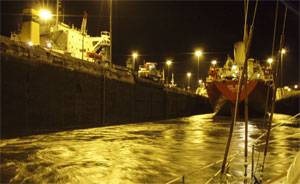 |
|
Water swirls into Gatun locks as Heretic is raised to the level of Gatun Lake. |
We could land. Once we’d explained that we needed to get to Colon, one of the officials phoned a taxi.
Driving down to Colon was a strange experience. Inside what used to be the American Canal Zone, everything still looked like a nice American suburb — the housing, the defunct schools, the defunct gyms, even the yellow fire hydrants. The only things wrong were the peeling paint and the lack of people. Then we crossed into Colon and were back among the concrete buildings, the vacant lots, the policemen with automatic rifles and the gangs with automatic rifles.
We made this journey, round-trip, eight times. We were tied up to that buoy, waking to the roaring of the howler monkeys, for nine days. Maybe the longest canal transit in history? We were sick and tired of howler monkeys by the end.
After a week of this, we finally got a tow. Not many people had offered; the threat of being fined for going under 8 knots cruising speed hung over pretty much everyone. Most cruising sailboats were between 34 and 40 feet back then, and very few were in the larger 42- to 50-foot category that’s increasingly normal today. So, most of them could barely motor at 6 knots on their own, let alone do so while towing another boat their size. A few sailors making the transit had generously offered on the spur of the moment, upon reaching the buoy and seeing us there. But we couldn’t accept because the Canal Authority required 48 hours’ notice of a tow.
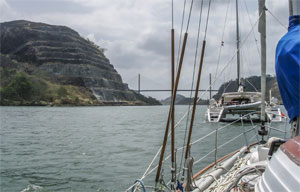 |
|
Under tow behind Orient Express in Gaillard Cut. |
A big boat for towing
By the end of the week, we were desperate. Standing on the dock of the yacht club after yet another afternoon of reasonable rejections, Seth and I spotted a center-console inflatable dinghy with a huge outboard. Maybe we could ask the owners if we could use it to tow our boat? When they arrived back on the dinghy dock, they were at first confused by our request. Then, understanding, the Turkish-American owner Selcuk asked, “But why should I not tow you with my big boat?”
The big boat was a 52-foot catamaran with two powerful engines. Selcuk and his French wife, Catherine, were scheduled to transit in two days — 48 hours. Seth and I thanked them profusely, and rushed off to the Port Captain’s office. Miraculously, he seemed to be the only person in the whole mess of the Canal Authority who found the bureaucracy as inefficient and irritating as we did. He stamped all our papers with a flourish and sent us on our way.
Back on Heretic, we broke the good news to Seth’s dad and to our friend who had remained on board. The other had, in the midst of this fiasco, secured a job on board a catamaran on delivery to Honolulu. So when the catamaran appeared on the mooring in the midst of its transit, Josh packed his bags and moved aboard his new ship. We were sad to see him go, but happy he’d found a good job and a new adventure.
The only thing left to do was find line handlers. Back to the Panama Canal Yacht Club. We’d told Selcuk that we’d find line handlers sufficient for both our boats and fortunately that didn’t take long, as two British tourists were eager to sign on and see the canal from the deck of a sailboat. Then we went back to Heretic, rowing out to her from the lock’s operations dock for the last time.
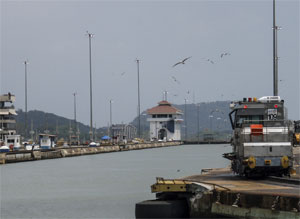 |
|
Miraflores locks, the last step down to sea level on the Pacific side of the canal. |
We couldn’t have been more thrilled to see Selcuk’s Orient Express tie up next to us on the buoy two nights later. At dawn, as we were securing our towlines, the pilot boat appeared again and deposited none other than Cooper, our first adviser, aboard. At first he was incredulous: “But I guided you up here a week ago! No, more than that!”
We told him the story and he shook his head and laughed, saying, “Well, now you go!”
And go we did. The towlines to Orient Express took up and we steered in her wake across the wide Gatun Lake and into the steadily narrowing channel that led to Gaillard Cut, where constant landslides had forced the canal’s engineers to change their plans again and again. Then we were at the gates to the Pedro Miguel locks, where we were carefully hauled alongside Orient Express to raft together in the center of the lock. This time, there was plenty of line handling as we dropped swiftly 31 feet to the small Miraflores Lake and the next two locks to the Pacific.
Before long, we were back down at sea level and then we were casting off from Orient Express, promising to see them in the anchorage, and hoisting sail. Heretic gathered way, and it felt wonderful.
Ellen Massey Leonard and her husband, Seth, completed a circumnavigation and have sailed to Alaska’s north coast.

